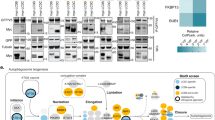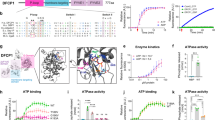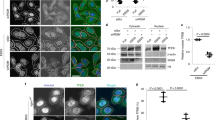Abstract
The ubiquitin-like molecule ATG12 is required for the early steps of autophagy. Recently, we identified ATG3, the E2-like enzyme required for LC3 lipidation during autophagy, as an ATG12 conjugation target. Here, we demonstrate that cells lacking ATG12–ATG3 have impaired basal autophagic flux, accumulation of perinuclear late endosomes, and impaired endolysosomal trafficking. Furthermore, we identify an interaction between ATG12–ATG3 and the ESCRT-associated protein Alix (also known as PDCD6IP) and demonstrate that ATG12–ATG3 controls multiple Alix-dependent processes including late endosome distribution, exosome biogenesis and viral budding. Similar to ATG12–ATG3, Alix is functionally required for efficient basal, but not starvation-induced, autophagy. Overall, these results identify a link between the core autophagy and ESCRT machineries and uncover a role for ATG12–ATG3 in late endosome function that is distinct from the canonical role of either ATG in autophagosome formation.
This is a preview of subscription content, access via your institution
Access options
Subscribe to this journal
Receive 12 print issues and online access
$209.00 per year
only $17.42 per issue
Buy this article
- Purchase on Springer Link
- Instant access to full article PDF
Prices may be subject to local taxes which are calculated during checkout







Similar content being viewed by others
References
Mizushima, N., Levine, B., Cuervo, A. M. & Klionsky, D. J. Autophagy fights disease through cellular self-digestion. Nature 451, 1069–1075 (2008).
Murrow, L. & Debnath, J. Autophagy as a stress-response and quality-control mechanism: implications for cell injury and human disease. Annu. Rev. Pathol. 8, 105–137 (2013).
Ichimura, Y. et al. A ubiquitin-like system mediates protein lipidation. Nature 408, 488–492 (2000).
Mizushima, N. et al. A protein conjugation system essential for autophagy. Nature 395, 395–398 (1998).
Ohsumi, Y. Molecular dissection of autophagy: two ubiquitin-like systems. Nat. Rev. Mol. Cell Biol. 2, 211–216 (2001).
Nemoto, T. et al. The mouse APG10 homologue, an E2-like enzyme for Apg12p conjugation, facilitates MAP-LC3 modification. J. Biol. Chem. 278, 39517–39526 (2003).
Tanida, I. et al. Apg7p/Cvt2p: a novel protein-activating enzyme essential for autophagy. Mol. Biol. Cell 10, 1367–1379 (1999).
Tanida, I., Tanida-Miyake, E., Komatsu, M., Ueno, T. & Kominami, E. Human Apg3p/Aut1p homologue is an authentic E2 enzyme for multiple substrates, GATE-16, GABARAP, and MAP-LC3, and facilitates the conjugation of hApg12p to hApg5p. J. Biol. Chem. 277, 13739–13744 (2002).
Bestebroer, J., V’kovski, P., Mauthe, M. & Reggiori, F. Hidden behind autophagy: the unconventional roles of ATG proteins. Traffic 14, 1029–1041 (2013).
Subramani, S. & Malhotra, V. Non-autophagic roles of autophagy-related proteins. EMBO Rep. 14, 143–151 (2013).
Radoshevich, L. et al. ATG12 conjugation to ATG3 regulates mitochondrial homeostasis and cell death. Cell 142, 590–600 (2010).
Raiborg, C. & Stenmark, H. The ESCRT machinery in endosomal sorting of ubiquitylated membrane proteins. Nature 458, 445–452 (2009).
Filimonenko, M. et al. Functional multivesicular bodies are required for autophagic clearance of protein aggregates associated with neurodegenerative disease. J. Cell Biol. 179, 485–500 (2007).
Lee, J-A., Beigneux, A., Ahmad, S. T., Young, S. G. & Gao, F-B. ESCRT-III dysfunction causes autophagosome accumulation and neurodegeneration. Curr. Biol. 17, 1561–1567 (2007).
Rusten, T. E. et al. ESCRTs and Fab1 regulate distinct steps of autophagy. Curr. Biol. 17, 1817–1825 (2007).
Kimura, S., Noda, T. & Yoshimori, T. Dissection of the autophagosome maturation process by a novel reporter protein, tandem fluorescent-tagged LC3. Autophagy 3, 452–460 (2007).
Baietti, M. F. et al. Syndecan–syntenin–ALIX regulates the biogenesis of exosomes. Nat. Cell Biol. 14, 677–685 (2012).
Katoh, K. et al. The ALG-2-interacting protein Alix associates with CHMP4b, a human homologue of yeast Snf7 that is involved in multivesicular body sorting. J. Biol. Chem. 278, 39104–39113 (2003).
Matsuo, H. et al. Role of LBPA and Alix in multivesicular liposome formation and endosome organization. Science 303, 531–534 (2004).
Segura-Morales, C. et al. Tsg101 and Alix interact with murine leukemia virus Gag and cooperate with Nedd4 ubiquitin ligases during budding. J. Biol. Chem. 280, 27004–27012 (2005).
Strack, B., Calistri, A., Craig, S., Popova, E. & Göttlinger, H. G. AIP1/ALIX is a binding partner for HIV-1 p6 and EIAV p9 functioning in virus budding. Cell 114, 689–699 (2003).
Von Schwedler, U. K. et al. The protein network of HIV budding. Cell 114, 701–713 (2003).
Zhai, Q. et al. Activation of the retroviral budding factor ALIX. J. Virol. 85, 9222–9226 (2011).
Zhou, X. et al. The HIV-1 p6/EIAV p9 docking site in Alix is autoinhibited as revealed by a conformation-sensitive anti-Alix monoclonal antibody. Biochem. J. 414, 215–220 (2008).
Cabezas, A., Bache, K. G., Brech, A. & Stenmark, H. Alix regulates cortical actin and the spatial distribution of endosomes. J. Cell Sci. 118, 2625–2635 (2005).
Pan, S. et al. Involvement of the conserved adaptor protein Alix in actin cytoskeleton assembly. J. Biol. Chem. 281, 34640–34650 (2006).
Bowers, K. et al. Degradation of endocytosed epidermal growth factor and virally ubiquitinated major histocompatibility complex class I is independent of mammalian ESCRTII. J. Biol. Chem. 281, 5094–5105 (2006).
Fevrier, B. & Raposo, G. Exosomes: endosomal-derived vesicles shipping extracellular messages. Curr. Opin. Cell Biol. 16, 415–421 (2004).
Théry, C., Zitvogel, L. & Amigorena, S. Exosomes: composition, biogenesis and function. Nat. Rev. Immunol. 2, 569–579 (2002).
Martin-Serrano, J. & Neil, S. J. Host factors involved in retroviral budding and release. Nat. Rev. Microbiol. 9, 519–531 (2011).
Sahu, R. et al. Microautophagy of cytosolic proteins by late endosomes. Dev. Cell 20, 131–139 (2011).
Petiot, A. et al. Alix differs from ESCRT proteins in the control of autophagy. Biochem. Biophys. Res. Commun. 375, 63–68 (2008).
Berg, T. O., Fengsrud, M., Stromhaug, P. E., Berg, T. & Seglen, P. O. Isolation and characterization of rat liver amphisomes-Evidence for fusion of autophagosomes with both early and late endosomes. J. Biol. Chem. 273, 21883–21892 (1998).
Fader, C. M., Sanchez, D., Furlan, M. & Colombo, M. I. Induction of autophagy promotes fusion of multivesicular bodies with autophagic vacuoles in k562 cells. Traffic 9, 230–250 (2008).
Moreau, K., Ravikumar, B., Renna, M., Puri, C. & Rubinsztein, D. C. Autophagosome precursor maturation requires homotypic fusion. Cell 146, 303–317 (2011).
Nair, U. et al. SNARE proteins are required for macroautophagy. Cell 146, 290–302 (2011).
Itakura, E., Kishi-Itakura, C. & Mizushima, N. The hairpin-type tail-anchored SNARE syntaxin 17 targets to autophagosomes for fusion with endosomes/lysosomes. Cell 151, 1256–1269 (2012).
Lu, Y., Zhang, Z., Sun, D., Sweeney, S. T. & Gao, F-B. Syntaxin 13, a genetic modifier of mutant CHMP2B in frontotemporal dementia, is required for autophagosome maturation. Mol. Cell 52, 264–271 (2013).
Gutierrez, M. G., Munafó, D. B., Berón, W. & Colombo, M. I. Rab7 is required for the normal progression of the autophagic pathway in mammalian cells. J. Cell Sci. 117, 2687–2697 (2004).
Jäger, S. et al. Role for Rab7 in maturation of late autophagic vacuoles. J. Cell Sci. 117, 4837–4848 (2004).
Ganley, I. G., Wong, P-M., Gammoh, N. & Jiang, X. Distinct autophagosomal-lysosomal fusion mechanism revealed by thapsigargin-induced autophagy arrest. Mol. Cell 42, 731–743 (2011).
Lee, J. Y. et al. HDAC6 controls autophagosome maturation essential for ubiquitin-selective quality-control autophagy. EMBO J. 29, 969–980 (2010).
Martina, J. A. et al. The nutrient-responsive transcription factor TFE3 promotes autophagy, lysosomal biogenesis, and clearance of cellular debris. Sci. Signal. 7, ra9 (2014).
Settembre, C. et al. TFEB links autophagy to lysosomal biogenesis. Science 332, 1429–1433 (2011).
Nath, S. et al. Lipidation of the LC3/GABARAP family of autophagy proteins relies on a membrane-curvature-sensing domain in Atg3. Nat. Cell Biol. 16, 415–424 (2014).
Bobrie, A., Colombo, M., Raposo, G. & Théry, C. Exosome secretion: molecular mechanisms and roles in immune responses. Traffic 12, 1659–1668 (2011).
Duran, J. M., Anjard, C., Stefan, C., Loomis, W. F. & Malhotra, V. Unconventional secretion of Acb1 is mediated by autophagosomes. J. Cell Biol. 188, 527–536 (2010).
Cheung, Z. H. & Ip, N. Y. Autophagy deregulation in neurodegenerative diseases—recent advances and future perspectives. J. Neurochem. 118, 317–325 (2011).
Nixon, R. A. Endosome function and dysfunction in Alzheimer’s disease and other neurodegenerative diseases. Neurobiol. Aging 26, 373–382 (2005).
Fung, C., Lock, R., Gao, S., Salas, E. & Debnath, J. Induction of autophagy during extracellular matrix detachment promotes cell survival. Mol. Biol. Cell 19, 797–806 (2008).
Sherer, N. M. et al. Visualization of retroviral replication in living cells reveals budding into multivesicular bodies. Traffic 4, 785–801 (2003).
Lee, H. H., Elia, N., Ghirlando, R., Lippincott-Schwartz, J. & Hurley, J. H. Midbody targeting of the ESCRT machinery by a noncanonical coiled coil in CEP55. Science 322, 576–580 (2008).
Théry, C., Amigorena, S., Raposo, G. & Clayton, A. Isolation and characterization of exosomes from cell culture supernatants and biological fluids. Curr. Protoc. Cell Biol. 30, 3.22.21–23.22.29 (2006).
Acknowledgements
Confocal microscopy was performed in the Biological Imaging Development Center at UCSF. Grant support to J.D. includes the NIH (CA126792, CA188404) and a Howard Hughes Medical Institute Physician-Scientist Early Career Award. This material is based on work supported by the National Science Foundation Graduate Research Fellowship to L.M. under grant DGE-1144247.
Author information
Authors and Affiliations
Contributions
L.M. and J.D. conceived the study and designed the experiments. L.M. performed the experiments and analysed the data. R.M. performed the mass spectrometry analysis. L.M. and J.D. wrote the manuscript.
Corresponding author
Ethics declarations
Competing interests
The authors declare no competing financial interests.
Integrated supplementary information
Supplementary Figure 1 Generation of pBABE, WTATG3, and KR cells and analysis of mCherry-GFP-LC3 in atg3+/+ and atg3−/− MEFs.
(a) Overview of the ubiquitin-like conjugation systems required for autophagy and formation of the ATG12-ATG3 conjugate. ATG12 is conjugated to lysine 243 (K243) of ATG3. (b) Stable pools of atg3−/− MEFs expressing an empty vector control (pBabe), wild-type mouse ATG3 (WTATG3) or the ATG3 K243R (KR) mutant were transduced with FLAG-HA-ATG12 (FHA-ATG12). Lysates were immunoblotted for anti-HA to detect ATG12 conjugates. (c) Lysates from stable pools of atg3−/− MEFs expressing an empty vector control (pBabe), V5-tagged wild-type mouse ATG3 (WTATG3) or V5-tagged mutant K243R ATG3 (KR) were immunoprecipitated with anti-V5. Immune complexes (IP V5) were resolved by SDS-PAGE and immunoblotted with anti-ATG3 and anti-ATG12 to detect the ATG12-ATG3 conjugate. (d) atg3−/− MEFs expressing mCherry-GFP-LC3 were grown in full media (Full), starved in Hank’s buffered saline solution (HBSS) for 2 h, or treated with bafilomycin A (Baf A, 50 nM). Scale bar, 20 μm. (e) atg3+/+ MEFs expressing mCherry-GFP-LC3 were grown in full media (Full), HBSS starved for 2 h, or treated with Baf A (50 nM) for 2 h. Scale bar, 20 μm. (f) Quantification of the percentage of mature autolysosomes, delineated as mCherry-positive, GFP-negative (mCherry-only) puncta as described in e and Fig. 1a–c (mean ± s.e.m.; n = 200 cells pooled from three independent experiments). Data for WTATG3 cells is the same as that presented in Fig. 1c. Statistical significance calculated using ANOVA, followed by Tukey’s HSD test. (g) Indicated cell types expressing mCherry-GFP-LC3 were treated for 2 h with bafilomycin A (Baf A, 50 nM) to block lysosome function. Scale bar, 20 μm. Uncropped images of blots are shown in Supplementary Fig. 6.
Supplementary Figure 2 Cells lacking ATG12-ATG3 accumulate perinuclear late endosomes.
(a) Quantification of the number of LBPA puncta as described in Fig. 2d (mean ± s.e.m.; n = 60 cells pooled from three independent experiments). Statistical significance calculated using ANOVA, followed by Tukey’s HSD test (∗∗∗P < 0.001). (b) Cells were immunostained with anti-CD63 and DAPI. The perinuclear CD63+ fraction was defined as the fraction of CD63 area located within 5 μm of the nucleus. Cells with completely clustered CD63 localization have a perinuclear CD63+ fraction close to 1. Scale bar, 10 μm. (c) Quantification of the perinuclear CD63+ fraction as described in b (mean ± s.e.m.; n = 60 cells pooled from three independent experiments). Statistical significance calculated using ANOVA, followed by Tukey’s HSD test (∗∗∗P < 0.001).
Supplementary Figure 3 Endolysosomal trafficking of Bodipy-LDL.
Stable pools of atg3−/− MEFs expressing an empty vector control (pBabe), wild-type mouse ATG3 (WTATG3) or the ATG3 KR mutant were used for experiments as indicated. (a) atg3−/− MEFs stably expressing wild-type mouse ATG3 (WTATG3) were incubated with Bodipy-LDL for 15 min at 37 °C in serum-free medium followed by a chase in full media for the indicated times. Cells were immunostained with anti-EEA1 to mark early endosomes, anti-lysobisphosphatidic acid (LBPA) to mark late endosomes, and anti-LAMP1 to mark lysosomes. Colocalized pixels are highlighted in white using the Colocalization plugin in ImageJ. Scale bar, 5 μm. (b) Indicated cell types were incubated with Bodipy-LDL for 15 min at 37 °C in serum-free medium followed by a 2 h chase in full media. When indicated, Baf A (50 nM) was used during the chase to block lysosome function. Quantification of the percentage of LDL puncta colocalized with LAMP1 is shown. Data for untreated cells (CTL) is the same as Fig. 3d. Data are presented as median (horizontal line), interquartile range (box), and 10–90th percentile (whiskers); n = 100 cells pooled from three independent experiments. Statistical significance calculated using ANOVA, followed by Tukey’s HSD test (∗∗P < 0.01). (c) Stable pools of reconstituted atg3−/− MEFs were incubated with Bodipy-LDL for 15 min at 37 °C followed by a 2 h chase in full media. Cells were immunostained with anti-LBPA to mark late endosomes. Colocalized pixels were highlighted in white using the Colocalization plugin in ImageJ. Scale bar, 5 μm. (d) Indicated cell types were incubated with Bodipy-LDL for 15 min at 37 °C in serum-free media followed by a 2 h chase in full media. Cells were immunostained with anti-EEA1 to mark early endosomes. Quantification of the percentage of LDL puncta colocalized with EEA1 is shown. Data are presented as interquartile range (box) and 90th percentile (whiskers); n = 100 cells pooled from three independent experiments. Statistical significance calculated using ANOVA, followed by Tukey’s HSD test.
Supplementary Figure 4 ATG12-ATG3 conjugation does not affect early endosome or lysosome function.
(a) Indicated cell types were incubated with fluorescently labeled transferrin (Tfn, red) for 15 min at 37 °C in serum-free media followed by a chase in full media for the indicated times. Cells were immunostained for EEA1 (green) to mark early endosomes. Scale bar, 10 μm. (b) Indicated cell types were incubated with Tfn as described in a and chased in full media for the indicated times. Tfn uptake as measured by fluorescence at time 0 and Tfn recycling as measured by a decrease in fluorescence over time were quantified by flow cytometry. Data are presented as mean ± s.e.m. relative fluorescence intensity; n = 3 independent experiments. Statistical significance calculated using ANOVA, followed by Tukey’s HSD test. (c) Indicated cell types were incubated with LysoSensor DND-189 or DND-153 to measure acidic (pH < 5.2) and total lysosomal content, respectively. Data is presented as mean ± s.e.m. relative fluorescence intensity; n = 3 independent experiments. Statistical significance calculated using ANOVA, followed by Tukey’s HSD test. (d) Indicated cell types were incubated with fluorogenic Magic Red cathepsin B or cathepsin L substrates to measure cathepsin activity. Data is presented as mean ± s.e.m. relative fluorescence intensity; n = 3 independent experiments. Statistical significance calculated using ANOVA, followed by Tukey’s HSD test.
Supplementary Figure 5 ATG12-ATG3 interacts with Alix (also known as PDCD6IP).
ATG12 was immunoprecipitated from atg5−/− MEFs stably expressing tandem tagged FLAG-HA-ATG12. Eluted proteins were resolved by SDS-PAGE, and Coomassie-stained protein bands were subject to LC-MS/MS analysis. Alix was identified (n = 2 independent experiments); bold underlined sequences correspond to independent peptides identified by mass spectrometry.
Supplementary information
Supplementary Information
Supplementary Information (PDF 739 kb)
Rights and permissions
About this article
Cite this article
Murrow, L., Malhotra, R. & Debnath, J. ATG12–ATG3 interacts with Alix to promote basal autophagic flux and late endosome function. Nat Cell Biol 17, 300–310 (2015). https://doi.org/10.1038/ncb3112
Received:
Accepted:
Published:
Issue Date:
DOI: https://doi.org/10.1038/ncb3112
This article is cited by
-
Unconventional protein secretion (UPS): role in important diseases
Molecular Biomedicine (2023)
-
Context-specific regulation of extracellular vesicle biogenesis and cargo selection
Nature Reviews Molecular Cell Biology (2023)
-
Autophagy and autophagy-related pathways in cancer
Nature Reviews Molecular Cell Biology (2023)
-
Crosstalk between exosomes and autophagy in spinal cord injury: fresh positive target for therapeutic application
Cell and Tissue Research (2023)
-
Exosomes and autophagy in ocular surface and retinal diseases: new insights into pathophysiology and treatment
Stem Cell Research & Therapy (2022)



